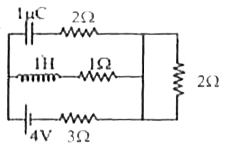Where does the energy of a capacitor reside ?
To answer the question "Where does the energy of a capacitor reside?", we can break down the explanation step by step:
1. Understanding the Capacitor Structure:
- A capacitor consists of two conductive plates separated by an insulating material (dielectric). When a voltage is applied across the plates, one plate becomes positively charged while the other becomes negatively charged.
2. Charge Distribution:
- When connected to a voltage source, electrons are removed from one plate (making it positively charged) and are deposited onto the other plate (making it negatively charged). This creates a potential difference between the plates.
3. Formation of Electric Field:
- The separation of charges creates an electric field between the plates. The electric field (E) points from the positively charged plate to the negatively charged plate.
4. Energy Storage in Electric Field:
- The energy in a capacitor is stored in the electric field created between the plates. This energy is a result of the work done to separate the charges against the electric field.
5. Energy Formula:
- The energy (U) stored in a capacitor can be mathematically expressed as:
U=12CV2
where C is the capacitance and V is the voltage across the capacitor.
6. Steady State Behavior:
- Initially, when the capacitor is connected to a circuit, it behaves like a short circuit (allowing current to flow). Once fully charged, it reaches a steady state where it acts as an open circuit, and the energy remains stored in the electric field.
Conclusion:
The energy of a capacitor resides in the electric field established between its plates due to the separation of positive and negative charges.
---
- A capacitor consists of two conductive plates separated by an insulating material (dielectric). When a voltage is applied across the plates, one plate becomes positively charged while the other becomes negatively charged.
- When connected to a voltage source, electrons are removed from one plate (making it positively charged) and are deposited onto the other plate (making it negatively charged). This creates a potential difference between the plates.
- The separation of charges creates an electric field between the plates. The electric field (E) points from the positively charged plate to the negatively charged plate.
- The energy in a capacitor is stored in the electric field created between the plates. This energy is a result of the work done to separate the charges against the electric field.
- The energy (U) stored in a capacitor can be mathematically expressed as:
U=12CV2
where C is the capacitance and V is the voltage across the capacitor.
- Initially, when the capacitor is connected to a circuit, it behaves like a short circuit (allowing current to flow). Once fully charged, it reaches a steady state where it acts as an open circuit, and the energy remains stored in the electric field.
The energy of a capacitor resides in the electric field established between its plates due to the separation of positive and negative charges.
Topper's Solved these Questions
- BOOK - VMC MODULES ENGLISHCHAPTER - CAPACITORSEXERCISE - LEVEL 0 (Short Answer Type)19videos
CAPACITORS
- BOOK - VMC MODULES ENGLISHCHAPTER - CAPACITORSEXERCISE - LEVEL 0 (LONG ANSWER TYPE)3videos
CAPACITORS
- BOOK - VMC MODULES ENGLISHCHAPTER - BASIC MATHEMATICS & VECTORSEXERCISE - Impeccable50videos
BASIC MATHEMATICS & VECTORS
- BOOK - VMC MODULES ENGLISHCHAPTER - CURRENT ELECTRICITYEXERCISE - IN-CHAPTER EXERCISE-F10videos
CURRENT ELECTRICITY
Similar Questions
Explain from where does the energy to run a car come.
View SolutionWhat happens to the energy stored in a capacitor if after disconnecting the battery, the plates of a charged capacitor are moved farther
View SolutionA capacitor in an LC oscillation has a maximum potential difference of 1.5 and a maximum energy 360μJ. At a certain instant the energy in the capacitor is 40μJ, the potential difference across the capacitor is V volt?
View SolutionIn the steady state of the circuit shown in the figure the ratio of energy stored in the inductor to th energy stored in the capacitor is 1000000.
 View Solution
View SolutionAnswer the following:
(a) Describe briefly the process of transferring charge between the two plates of a parallel plate capacitor when connected to a battery. Derive an expression for the energy stored in a capacitor.
(b) A parallel plate capacitor is connected to a battery of potential difference V. It is disconnected from battery and then connected to another uncharged capacitor of the same capacitance. Calculate the ratio of the energy stored in the combination to the initial energy on the single capacitor.View SolutionWhere does a centromere occur?
View SolutionA capacitor of capacitor 5.00μF is charged to24.0V and another capacitor of capacitance 6.0μF is charged to 12.0V (a) Find the energy stored in each capacitor .(b)The positive plates of the first capacitor is now connected to the negative plate of the second and vice versa . Find the new charges on the capacitors .(c)Find the loss of electrostatic energy during the process .(d)Where does this energy go?
View SolutionA capacitor is connected across an inductor. At time t = 0 charge on the capacitor is equal to 1√2qmax, where qmax is the maximum charge on the capacitor. The time t, at which the energy stored in the capacitor is equal to the energy stored in the inductor is (The inductance of the inductor is L and capacitance of the capacitor is C. Resistance of the circuit is zero)
View SolutionSTATEMENT 1: Energy stored in the capacitor is less than the energy battery during the charging of capacitor. because
STATEMENT-2: Some of the energy is converted into heat.View SolutionSTATEMENT-1 : If the distance plates of a charged isolated capacitor increases, then the potential energy in the electric field of capacitor increases.
and
STATEMENT-2 : The energy stored in a capacitor is always directly proportional to separation between the plates.View Solution

